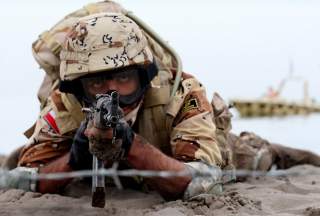What Comes Next for Iran's Defense Doctrine?
Tehran is gradually shedding its defensive posture in favor of an offensive disposition.
Iranian leaders learned a series of hard lessons from the war with Iraq. They found the regional environment full of hostile parties; other than Syria, there was no reliable regional or international partner. Not only did the United States side with Iraq during the war, but it also imposed tight sanctions on Iran’s military imports, with the exception of the Iran-Contra deal. 1992’s regulations of the Iranian Armed Forces, while laying the foundation for a defensive strategy, emphasized self-sufficiency in defense, with the core objective being the defense of the homeland by deterring and defeating the aggressors. After the 9/11 attacks, defense thinking shifted to new dimensions, such as missiles-based deterrence and the achievement of nonconventional means—the nuclear option. The quick fall of the Saddam Hussein regime in Iraq, by May 2003, gave the doctrine a new impetus to combine conventional deterrents with psychological and asymmetric warfare to deter the United States.
By 2005, the Iranian armed forces, spearheaded by the Revolutionary Guard, had fully designed its defensive warfighting strategies and tactics, what is dubbed “mosaic defense,” to face off with U.S. forces stationed in Afghanistan and Iraq, should the United States choose to attack Iran. The concept of mosaic defense is based on the ideas of asymmetric warfare and the use of mass mobilization to deny the invading army any safe zone inside Iran. The idea is to allow enemy forces advance deep inside Iran and then make it fall prey to counterattacks from behind and from all directions, like what the Soviet Red Army did to Hitler’s invading forces during World War II. There is also an ideological component tied to mosaic defense. Former Revolutionary Guard commander Brig. Gen. Yahya Rahim Safavi claimed in a March 2005 speech that the Guard would fight for endless defense on land, sea and in the air with “a spirit of jihad and martyrdom-seeking.”
The Arab Spring has brought about a qualitative change in Iran’s defense doctrine by letting it choose a forward defense policy beyond its national borders. The Revolutionary Guard soldiers are deeply involved in the fight against the ISIS in Iraq; they are also defending the Bashar al-Assad government in Syria against a bevy of diverse rebel groups supported by the United States, Saudi Arabia, Qatar and Turkey. Iran sees ISIS as an existential threat, and the Guard justifies its military involvements in Iraq as forward deterrent actions to eliminate the ISIS threat before it can reach Iran. Iran’s postrevolutionary policy efforts to shrink U.S. influence in the Middle East, such as its 2004 proposal to launch a collective security framework in the Gulf minus the United States, and its sheer strategic need to maintain a vital link to Lebanon’s Hezbollah through a friendly regime in Damascus, have also played decisive roles in its military engagement in Iraq and Syria.
What Happens Next?
What emerges is that Iran’s defense doctrine is gradually shedding its defensive posture in favor of an offensive disposition, though deterrent-based defense still largely defines it. The serious question is whether Iran would also militarily engage itself against ISIS-like groups in other nearby, if not distant, countries in the future. It cannot but cause concern in neighboring countries.
Another big concern for Iran’s neighbors is the way it is augmenting its military might, what may be called Iran’s drive for power maximization—a military goal also sought by revisionist states like Germany under Hitler or Japan during the Meiji Restoration. Of course, the Gulf Arab neighbors, particularly Saudi Arabia, are suffering from a security dilemma that further pushes them down the court toward the United States, to secure defense commitments and supplies. That defeats Iran’s original purpose: the assertion of regional preeminence through major boosts in defense capabilities, without scaring its neighbors.
Mohammed Nuruzzaman is associate professor of international relations at Gulf University for Science and Technology in West Mishref, Kuwait.
Image: IRGC commandos and missile boats during the Great Prophet IX exercise. Wikimedia Commons/Creative Commons/Shahab-o-din Vajedi

